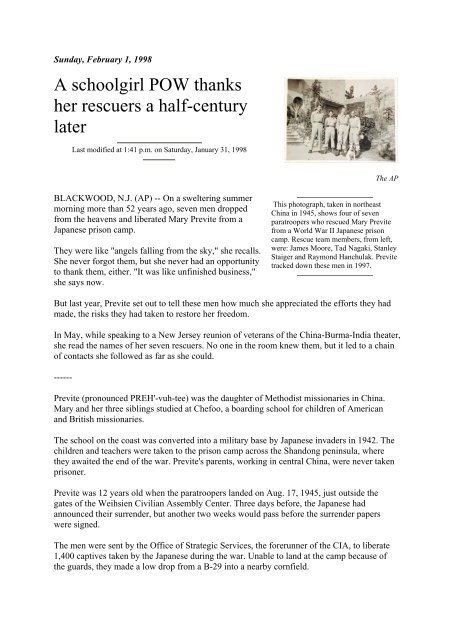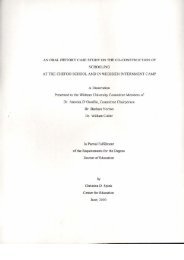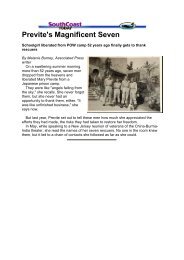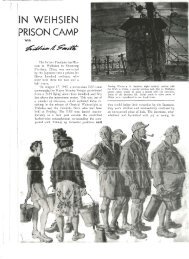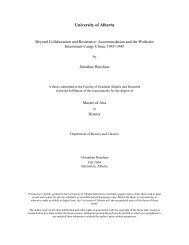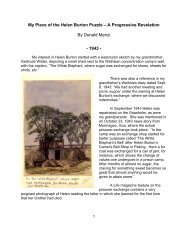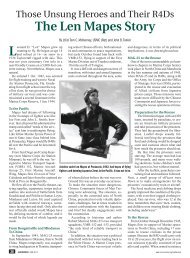A schoolgirl POW - Weihsien-Paintings
A schoolgirl POW - Weihsien-Paintings
A schoolgirl POW - Weihsien-Paintings
You also want an ePaper? Increase the reach of your titles
YUMPU automatically turns print PDFs into web optimized ePapers that Google loves.
Sunday, February 1, 1998<br />
A <strong>schoolgirl</strong> <strong>POW</strong> thanks<br />
her rescuers a half-century<br />
later<br />
Last modified at 1:41 p.m. on Saturday, January 31, 1998<br />
The AP<br />
BLACKWOOD, N.J. (AP) -- On a sweltering summer<br />
morning more than 52 years ago, seven men dropped<br />
from the heavens and liberated Mary Previte from a<br />
Japanese prison camp.<br />
They were like "angels falling from the sky," she recalls.<br />
She never forgot them, but she never had an opportunity<br />
to thank them, either. "It was like unfinished business,"<br />
she says now.<br />
This photograph, taken in northeast<br />
China in 1945, shows four of seven<br />
paratroopers who rescued Mary Previte<br />
from a World War II Japanese prison<br />
camp. Rescue team members, from left,<br />
were: James Moore, Tad Nagaki, Stanley<br />
Staiger and Raymond Hanchulak. Previte<br />
tracked down these men in 1997.<br />
But last year, Previte set out to tell these men how much she appreciated the efforts they had<br />
made, the risks they had taken to restore her freedom.<br />
In May, while speaking to a New Jersey reunion of veterans of the China-Burma-India theater,<br />
she read the names of her seven rescuers. No one in the room knew them, but it led to a chain<br />
of contacts she followed as far as she could.<br />
------<br />
Previte (pronounced PREH'-vuh-tee) was the daughter of Methodist missionaries in China.<br />
Mary and her three siblings studied at Chefoo, a boarding school for children of American<br />
and British missionaries.<br />
The school on the coast was converted into a military base by Japanese invaders in 1942. The<br />
children and teachers were taken to the prison camp across the Shandong peninsula, where<br />
they awaited the end of the war. Previte's parents, working in central China, were never taken<br />
prisoner.<br />
Previte was 12 years old when the paratroopers landed on Aug. 17, 1945, just outside the<br />
gates of the <strong>Weihsien</strong> Civilian Assembly Center. Three days before, the Japanese had<br />
announced their surrender, but another two weeks would pass before the surrender papers<br />
were signed.<br />
The men were sent by the Office of Strategic Services, the forerunner of the CIA, to liberate<br />
1,400 captives taken by the Japanese during the war. Unable to land at the camp because of<br />
the guards, they made a low drop from a B-29 into a nearby cornfield.
A Salvation Army band began playing "The Star-Spangled Banner" and the prisoners hoisted<br />
their rescuers onto their shoulders. Suddenly, unexpectedly, the war was over for them, and<br />
they were free.<br />
"The camp went berserk. We didn't know the war was over," Previte recalls. "People were<br />
dancing, weeping, pounding the ground."<br />
Weeks would pass before Mary and her siblings would be reunited with their parents after a 5<br />
1/2-year separation.<br />
They returned to the United States. Mary married, had a daughter, divorced. She taught<br />
English, and went to work as administrator of Camden County's youth detention center.<br />
She has run the jail since 1974 and says she draws upon her prison camp experience as she<br />
seeks to bring a sense of safety and order to the lives of juveniles awaiting trial.<br />
Last year, she was chosen president of the New Jersey Juvenile Detention Association and<br />
was elected in November to the state Assembly, where she hopes to be an advocate for<br />
troubled youngsters.<br />
In 1985, Previte obtained a copy of a declassified military mission report from a fellow camp<br />
survivor. In it were the names of her rescuers. She tucked it away; it would be impossible to<br />
find them, she thought.<br />
------<br />
On a whim, at the meeting of the veterans group in Mount Laurel, she read the names. "Never<br />
in my wildest dreams did I think I would ever be able to find all of these people," says Previte,<br />
65.<br />
In October, a notice in the group's newsletter produced the first lead: The widow of Raymond<br />
Hanchulak was living in central Pennsylvania in Bear Creek Village. Her husband, a medic on<br />
the mission, died the previous year.<br />
Meanwhile, a man who had been at the May meeting sent Previte pages and pages of names<br />
gleaned from the Internet to check out. The search seemed daunting: There were more than<br />
150 listings just for James Moore.<br />
Then Previte found Peter Orlich's widow, Carol, in the New York City borough of Queens.<br />
Orlich, a radio operator and the youngest of the group, died in 1993 at age 70. He, too, had<br />
tried to locate the others, unsuccessfully.<br />
"If he were only alive -- what this would have meant to him. It's just hard for me to imagine,"<br />
Mrs. Orlich says.<br />
She sent Previte a piece of yellowed silk parachute embroidered with the men's signatures that<br />
her husband had kept in his dresser drawer.<br />
"Now I was really heartsick because my first two connections were with two widows," Previte<br />
says. "I thought I could not wait one more minute to start calling every name on this list."'
She found Tad Nagaki, a Japanese-American interpreter on the mission. Now 77, he is a<br />
recently widowed beet farmer in Alliance, Neb. Nagaki sent Previte photographs his wife kept<br />
in a wartime scrapbook.<br />
Nagaki told Previte how to find Moore, 78, of Dallas, who attended the same Chefoo<br />
missionary school before joining the FBI and then the OSS. He later joined the CIA and<br />
retired in 1978.<br />
Moore, with help from a neighbor with a national computer database, joined Previte's search<br />
for the remaining men.<br />
He found Stanley Staiger, 79, the mission commander, recovering from a broken hip at his<br />
Nevada home. The last, James Hannon, was located by Moore in Yucca Valley, Calif., where<br />
he is a writer, drafting plot summaries about the war.<br />
Previte ended her search without locating the seventh man, Eddie Wang, the Chinese<br />
interpreter. The others said he was a Chinese nationalist and they had no idea how to find him.<br />
For Previte, it was an immensely gratifying experience.<br />
"It's never too late to say thank you," Previte says. "It's been like goosebumps up and down<br />
my spine to be able to say thank you to these men after 52 years. I told them I have so much<br />
to be thankful for."<br />
She has been getting to know her rescuers and what happened to them after the war. They<br />
were surprised by her interest in their lives.<br />
"I don't think we made that much of a difference. It could have been anybody," Moore says,<br />
modestly. "It's nice of her to remember us."<br />
Staiger was a stockbroker and hotel owner before retiring in Reno. "We did our job, not<br />
knowing what would happen when we parachuted in," Staiger says. "We had a few rough<br />
moments with the Japanese, but everything worked itself out."<br />
Previte would like to organize a reunion of the group, but the men's failing health may prevent<br />
that. She plans to keep in touch.<br />
"We were bonded by a war that wrapped us together for so many different reasons," Previte<br />
says. "We've become family now."<br />
Copyright 1997 The Shawnee News-Star


